Calendars
A friend of mine recently put forward the theory that differences in the historical levels of technical sophistication between human cultures are largely a matter of latitude. His thinking is that the further an ancient society lived from the equator, the more affected they were by the changing seasons. To survive, societies at higher latitudes were forced to develop science and technology. In contrast, those closer to the equator had everything at hand year-round, and merely needed to know how to harvest nature’s bounty. I recall Somerset Maugham’s description of the Malay as a people who “wait for the next coconut to fall.” That definitely smells of chauvinism, perhaps even racism, but my friend’s theory got me thinking about the role calendars play in human societies. Many years ago, I heard that the Balinese maintain two entirely independent calendars, one based on the lunar cycle, the other on the rice growing cycle (and note, Bali is only ~8.4° south of the equator). More recently I became aware of a famous Aztec calendar stone, and just the other day I stumbled upon a truly crazy attempt to explain the mysterious Phaistos disk as a Minoan calendar. This article gives me a chance to knock off a personal task that has been simmering away for about 30 years, which is to focus my attention properly on interesting ancient calendars.
Calendar Basics
The purpose of calendars is obvious – they are a way of keeping track of the passage of time and allow us to schedule for future events. At a very basic level, our lives could be described as the superposition of several repetitive events whose mix changes according to our age and the weather outside. Time to breastfeed, time to eat, time to sleep, time to wake up, time to hunt, time to seek shelter, time to move to higher pastures, time to store for winter, time to do taxes… I would imagine primitive calendars – scratches on cave walls and the like – began at the dawn of time for our species. I feel like taking note of regularly occurring cycles and fixing them in space and time, and then predicting them, is a very basic human urge, the more so back when people lived in much closer contact with the outside world, with no distractions like lights or phones. I scoff when people are amazed that rock cairns in the Atacama Desert or medicine wheels on the prairies line up with solstices and equinoxes – it seems like an obvious thing to do and would not require too much effort or imagination. Further, I would argue that the intellectual steps to go from that to calendars are not too involved. We seem to have no problem creating them – Wikipedia lists 84 calendars! (Wikimedia Foundation, Inc., 2018c)
The alternations between day and night are such a fundamental aspect of life that days are usually the basic unit of every calendar. Beyond that the connections between the weather, the seasons and the movement of the moon and sun are also very obvious, and so most calendars are based on the lunar and or solar cycles. Once the basics are established, a calendar lends itself to tracking everything else in our lives, such as religious festivals (in fact, one could see religion growing out of a worship of calendar-tracked dates of celestial significance), hunting or grazing schedules, and so on. While it is interesting how various calendars divide time into weeks / months / years, and synchronize the lunar cycle with the solar, I have decided to focus elsewhere in this article. Instead I will discuss a few calendars that possess unique aspects, especially ones with interesting cultural aspects woven into their fabric.
The Calendars of Bali
Bali’s rich schedule of religious and cultural festivals and rituals is tightly tied to the interplay between two historical calendars, and nowadays they also observe the western Gregorian calendar as well.
Saka Calendar
This is a lunar calendar with twelve 30-day months per year. It does not have too much to distinguish it other than the use of unique additional days and months to keep the calendar in synch with the solar one. The Balinese practice a local form of Hinduism, and so many of the names in the calendar derive from Sanskrit. The year starts on a festival day called Nyepi, which occurs each year on the day after the first new moon in the 9th month, which was March 17 this year (2018). It is a day of silence and self-reflection. Starting at 6am people are not allowed to do anything really – no phones, TV, work, and everything shuts down except for emergency services, especially relating to childbirth. The island falls eerily silent, with empty beaches, and no flights in or out.
The day of the full moon is very special in Bali and is given the name Purnama. The people feel that these days are very auspicious and are a good time to hold weddings, plant crops, and other important events. The Balinese make many offerings throughout the year, but amp them up for Purnama, often starting preparations days in advance.
Pawukon Calendar
This is the more interesting of the two calendars. It evolved during the time of the vast Hindu Majapahit Kingdom, which ultimately was eclipsed by Islam, which still holds sway in the region. In 1478 the Majapahit royal family fled their seat in East Java and escaped to Bali, taking their calendar with them. Stay with me here, because it gets complicated. The year is 210 days long. Within that 210-day year there are ten different week systems running concurrently. In one of the systems, Ekawara, each week is only one day long, and that day is called Luang. Another, Dwiwara, is made up of two-day weeks, and the days are called Menga and Pepet. Yet another is called Triwara, with three-day weeks whose days are called Pasah, Beteng, and Kajeng. Those of you with an eye for these things will see the Sanskrit roots in “Dwi” and “Tri”, linguistic cousins to our “duo” and “tri”. Those of you with an aptitude for numerical patterns will have guessed that there are 4-day weeks, 5-day weeks, all the way up to 10-day weeks! And those of you who remember high school math will have calculated that the Balinese need to remember 55 different day names due to the fact that each week system will have different names for the days. Because the 4, 8, and 9-day week systems do not divide equally into 210, those week systems have the required number of days added at specific points so that all the ten weekly systems end evenly on the 210th day.
If that seems complicated, it gets more so. Each day in the 5, 7 and 10-day weeks is assigned a ritual value (urip), and some calculations involving the urip are used to determine the order of the days in the 1, 2, and 10-day weeks. Here is a description from (Wikimedia Foundation, Inc., 2018d):
For the ten-day week, the urip of the days are – from the first day to the tenth day – 5, 2, 8, 6, 4, 7, 10, 3, 9, 1. For the seven-day week, the urip of the days are – from first day to seventh day – 5, 4, 3, 7, 8, 6, and 9. For the five-day week, the urip of the days are – from the first day to the fifth day – 9, 7, 4, 8, 5.
For any particular day of the Pawukon, add the urip of the day of the 5-day week to the day of the seven-day week and then add one – if the sum is more than ten, then ten must be subtracted from it. This calculated value determines which day of the week it is in the 1-, 2-, and 10-day weeks. If the calculated value is even, then the day is Pepet in the two-day week and Luang in the one-day week. But, if the calculated value is odd then the day is Menga in the two-day week and is not a day of the one-day week. The day in the ten-day week is the one for which the calculated value matches its urip.
I imagine the priests on the island developed these mental gymnastics as a way of maintaining their monopoly over the spiritual aspects of life, but that’s just the cynic in me.
This devilishly complicated calendar has one redeeming feature – it is static, i.e. the arrangement of days is identical for every year, so people can just use a look up chart to determine what day it is. What is really fascinating, magical almost, is how many aspects of Balinese life are woven into the fabric of the Pawukon calendar. While the Saka calendar simply tracks the moon’s cycles, the Pawukon contains a treasure of cultural details. The length of the year is based on the 210 days it takes on average for Balinese rice plants to go from germination to flowering, and presumably certain farming tasks are associated with specific days, or were historically before fertilizers turbocharged rice growth. The 3-day cycle tracks the market days – every 3 days a different village holds its market. The day on which a person’s birthday falls in the 8-day week calendar is associated with his or her previous incarnations. There are numerous religious rituals in Bali – visitors are often baffled by them all – and their timings are all determined by congruences within the Pawukon calendar. For example, when the third day of the 3-day week falls on the same day as the fifth day of the 5-day week, it is a time for certain temple ceremonies. The 5-, 6-, and 7-day weeks hold the most ritualistic value, so one of the year’s most important days, Galungan, occurs the single time all three weeks end on the same day. All sorts of other agreements and congruences between the different calendar systems determine other events. An echo of the calendar’s complex interplay can be heard in Bali’s percussive gamelan music, a sophisticated and hypnotic interweaving of different instruments, beats and frequencies.

Figure 1 shows a traditional palalintanang, which a subset of the Pawukon calendar. It is a 7x5 matrix that acts as a horoscope, by capturing the intersections between the 7-day Hindu-Balinese week (Saptawara) in the columns, and the 5-day Javano-Balinese week (Pancawara) in the rows. The first and last rows are pictorial header and footer rows, showing the seven Hindu gods (top row) and the seven animals (bottom) associated with each day of the Hindu week. Each specific panel features a scene related to the birth characteristics of a person born on that day. Without going into details, using Excel I worked out that I was born on day 14 of the Pawukon year, and this day falls on the 7th column (Saniscara) and 5th row (keliwon) of the chart. This is pagelengan, the day one carries the ashes of corpses to the sea, making me a person who is likely to lead a dangerous life. Figure 2 shows that panel, with a man in a boat throwing floating ash urns into the sea. I have quite a bit of additional knowledge about the Pawukon calendar, mainly thanks to Jennifer White of the Spurlock Museum at the University of Illinois at Urbana-Champaign. Contact me if you’d like your Balinese fortune told, I have all the necessary tables now!
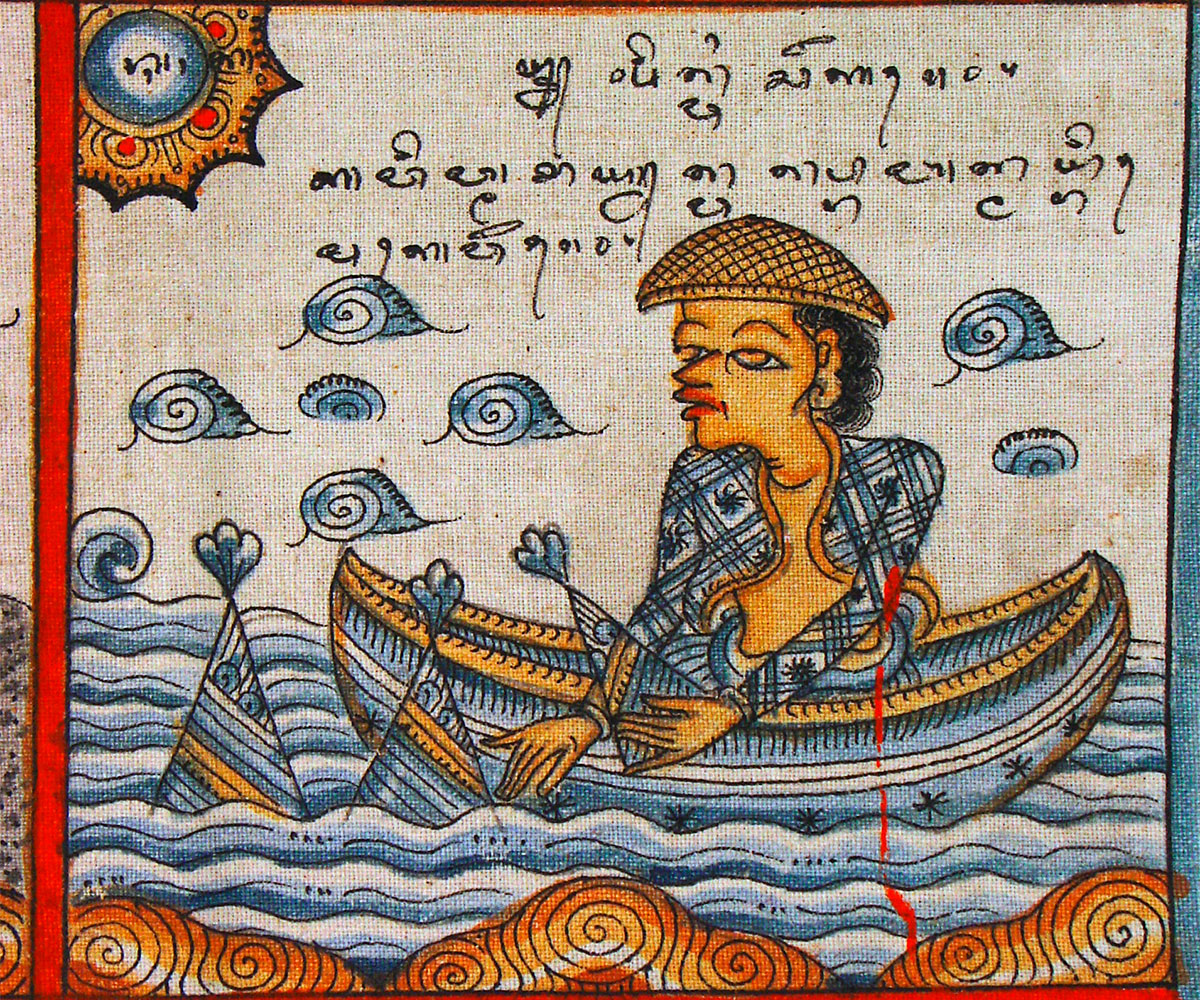
Inuit Calendar
A unique reality for the Inuit people is that they live so far north that it is difficult to track the seasons using the Sun and Moon. They do associate certain times of the year with the position of the stars. The far north is a harsh environment, and to survive the Inuit became experts at preparation. It was, and still is, critically important to hunt for and prepare the different types of meat, because a lack of edible meat would usually result in starvation. Each type of prey is usually only available in a relatively small temporal and geographical window. This requires being in the right place, at the right time, with the right people and equipment. Because of this, the Inuit developed an annual calendar that is populated by important details related to survival. The Inuit calendar is made up of six, sometimes seven, general seasons rather than our four seasons and they are referred to as: early spring, spring, summer, early fall, fall, and winter.
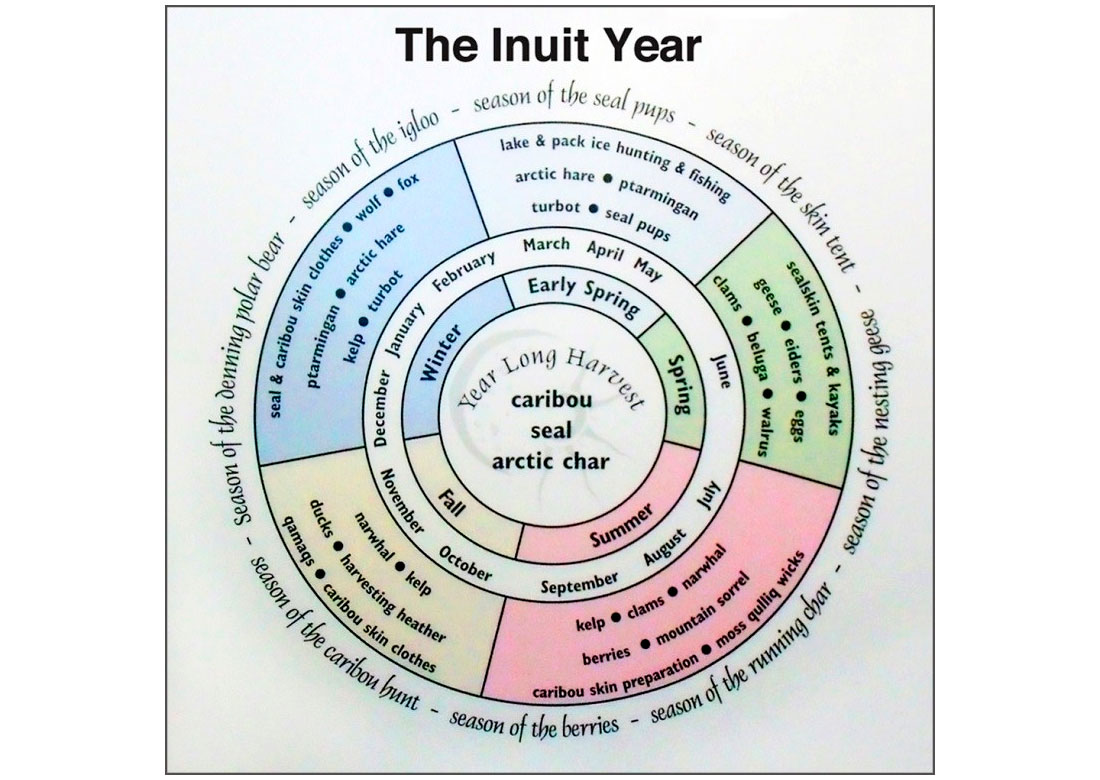
The weather, living habits of prey and other key factors vary from place to place, so each community tended to develop its own very specific oral calendar that revolved around the hunt for and processing of food. Figure 3 is a graphical depiction of such an Inuit calendar. Each uniquely named season is populated with a unique task list. Rather than a calendar made up of units of days, weeks and months, the Inuit calendars are collections of specific and important tasks and events associated with times of the year, categorized into seasons. For example, in Nunavik there is a period sometime around our January which is known as Naliqqaittuq, meaning weather so cold that one “can’t compete with it”. In the Baffin region there is a time in February known as Avunnisi, which means miscarriage – at this time some bearded seals miscarry. Also in Baffin, sometime in May is known as Tupiqtuut, meaning time to switch from snow houses to tents – I believe a literal translation is “ceilings fall down”. Manniliuti in Nunavik indicates the time when birds start laying eggs. And so on – it’s clear that the Inuit calendar is not some fancy pants festival calendar like Bali’s Pawukon, it developed as a raw, primordial tool necessary for each community’s survival.
The Phaistos Disc
The Phaistos Disc (Figure 4) is one of archaeology’s enduring mysteries. Discovered in 1908 in a Minoan palace in Phaistos, Crete, it probably dates from sometime between 1400 and 2000 B.C. Most experts believe the symbols in its spiral design represent some kind of Minoan script, but it has never been deciphered. Some sceptics think it is a forgery; I sometimes wonder if it is just a pretty design. Seals were used back then to seal and identify many items of commerce, such as amphorae filled with wine or honey. Perhaps someone pressed a random collection of such seals into the soft clay of a plate because they thought it looked attractive? However, tantalizing similarities with Egyptian and Anatolian hieroglyphs and the discovery of a Linear A script tablet nearby in the same layer have driven cryptologists mad with a desire to be the first to decipher the disc’s content. The fact that both sides are inscribed with symbols weighs against the artifact merely being a decorative plate, and the way the symbols are so methodically laid out and delineated certainly suggests that there is an intended message or meaning.
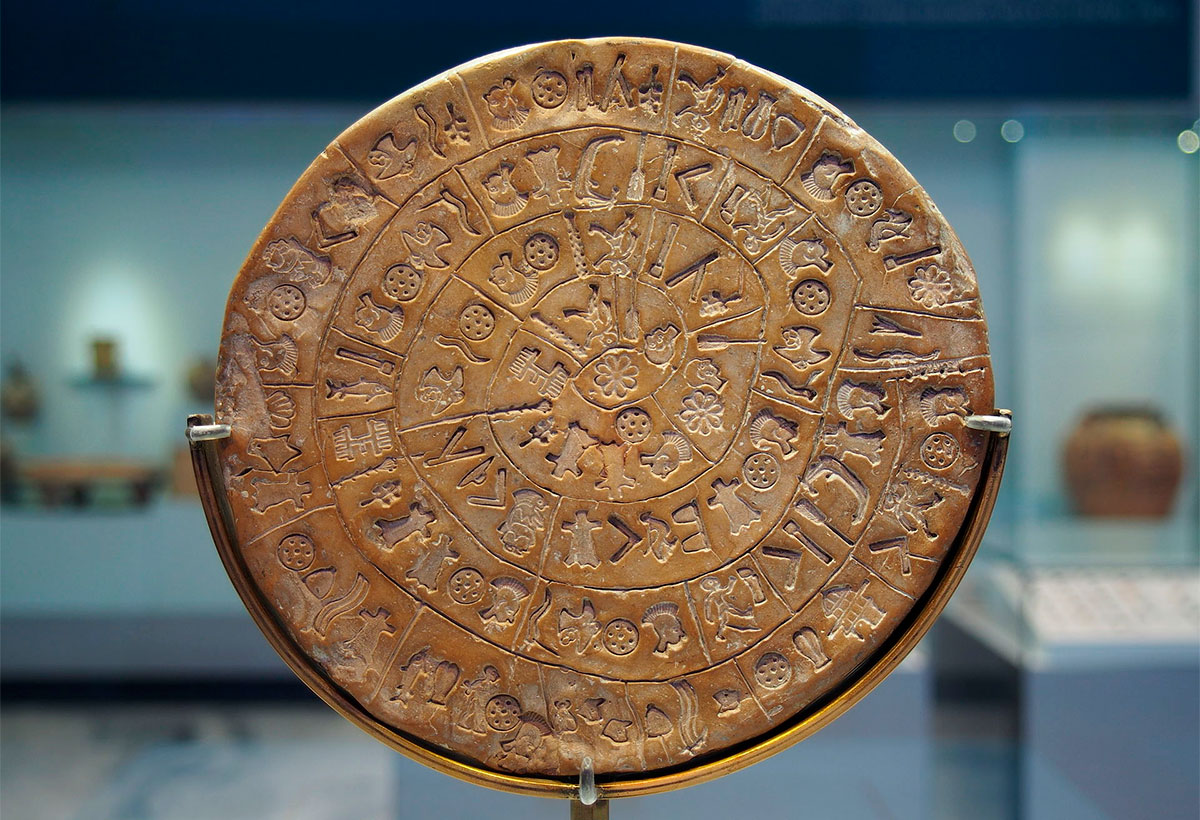
One persistent explanation for the disc’s purpose is that it is a calendar of some type. I should note here that there are many other explanations, including the disc being musical notation, a message from extra-terrestrials, a picture story, a prayer, and a board game. Many scholars have performed mental gymnastics to explain how the disc could have been a calendar. (Kilbourne Matossian, 2012) concludes that the disc “was created primarily to serve as a guide to the timing of agricultural activities and religious rituals.” Her arguments are relatively sober and appear to be founded on scholarly research. Others though veer into explanations that to me seem far fetched and incomprehensible – just search on “phaistos calendar” and you will find that this is a hotbed of crackpot theories. Ole Hagen in particular stands out for his many alternative mathematical explanations of the disc as a calendar. Given the complexity of the Balinese Pawukon calendar, it is perhaps plausible that the Phaistos Disc is in fact a calendar, though I personally doubt it.
The Aztec Calendar Stone
While the Phaistos Disc is a compact 45 cm in diameter and 1 cm thick, the Aztec calendar stone (Figure 5) is massive; with a diameter of over 3.5 m and a thickness of 1 m, it weighs around 24 tons. The stone was intricately carved by the Aztecs from a single block of basalt, probably just after 1500. Not long after that the Spanish invaded Mexico, and the stone was buried under the central square of Tenochtitlán (now Mexico City), the Aztec capital, during or after the final Spanish conquest in August of 1521. Either the Aztecs buried the stone in an attempt to hide it from the Spanish, or the Spanish buried it as part of their dismantling of Aztec culture, and the introduction of Catholicism as the official religion. The latter seems more likely given the stone was buried face down. The stone was rediscovered during repairs to the main cathedral in 1790.
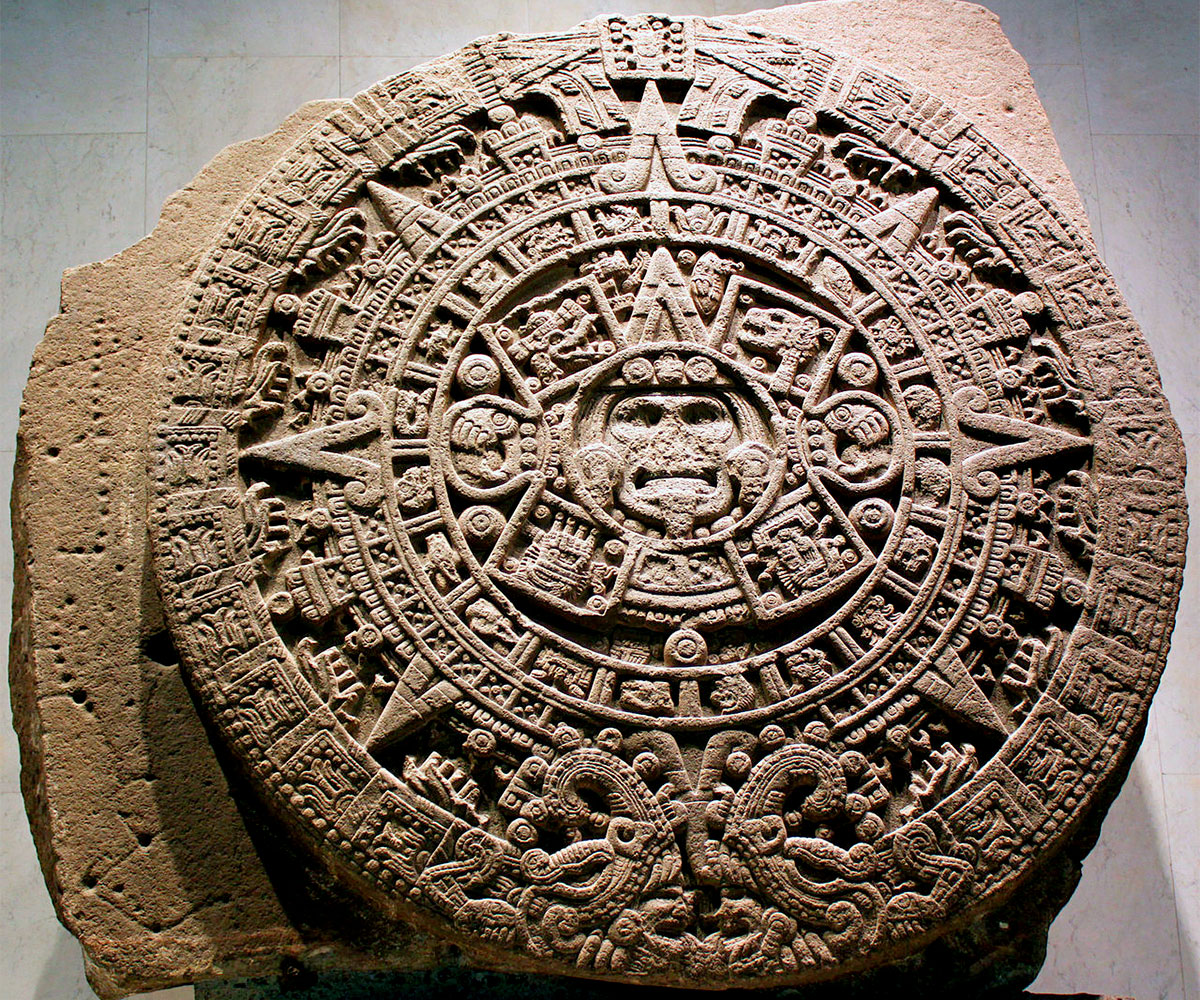
Much like the Phaistos Disc, there are competing theories about the Aztec calendar stone’s purpose. The first theory to be popularized, back in 1792, is that it is a calendar, and ever since then it has been known as the calendar stone, perhaps erroneously. It remains an important symbol of national Mexican identity, and still stimulates active debate.
The calendar explanation has similarities with the Balinese system in that the Aztecs followed two calendars. One was a solar year made up of 365 days called xiuhpohualli (“year count”), and the other was a ritual year made up of 260 days called tonalpohualli (“day count”). Combining these gave a 52-year (solar) “century” or “calendar round”, because it took this long for the two calendars to both end evenly at the same time (52 * 365 = 73 * 260). Scholars have perceived elements of these two calendars in the stone’s graphics and design, but others remain unconvinced that they actually represent a working calendar. There is no dispute that the stone contains calendar elements, such as the symbols for the 20 days in the tonalpohualli month – these are the 20 symbols in the first ring outside of the central set of motifs, starting with the first one, crocodile, and continuing in a counter-clockwise direction through wind, house, lizard, etc.
The central portion is dominated by a depiction of the Sun god Tonatiuh. His tongue is a stylized obsidian knife used in ritual sacrifices, and he is holding a human heart in each of his hands. The four quadrants around Tonatiuh represent the four eras of time that occurred prior to the current (fifth) one; after each era the world was destroyed and started afresh with the gods rearranging the heavens and providing the Earth with a new Sun. The Aztecs believed that the first era ended on a 4 Jaguar day, depicted in the upper right square, after 676 years when monsters devoured everything. Hurricane winds ended the second era on 4 Wind day (top left) after 364 years, and humans were turned into monkeys. The third era ended on 4 Rain day (bottom left), in a rain of fire after 312 years, and humans were turned into turkeys. After 676 years the world ended again on a 4 Water day in catastrophic floods, and humans were turned into fish. The current era is Ollin, an Aztec word translated as movement, but with a deeper meaning closer to passion, or action with intensity and intent.
One interpretation is that the central image of the stone shows Tonatiuh in his death throes during an eclipse, essentially a depiction of the end of the Ollin world. The priests believed that this would occur on a 4 Movement (Ollin) day, and supposedly had calculated that such an eclipse would not occur until the 21st century (sending an entirely different group of crackpots into a tizzy). Each year on 4 Movement day human sacrifices of great importance would be held, the idea being that if the gods were not appeased, they would end the world with an eclipse. Hence a more popular theory for the stone, that it was the Aztec’s most sacred and important sacrificial altar, with the carvings on it explaining its importance.
International Fixed Calendar
This calendar (Figure 6), developed by Moses B. Cotsworth in 1902, is the product of pure rationalism and common sense, completely at the opposite end of the spectrum from the previous calendars discussed. As you might expect, it never caught on (although George Eastman did impose it on his company, Kodak, and they used it for over 60 years)! In this calendar, a year is made up of 13 months, each made up of 28 days (4 weeks * 7 days). That obviously gives 364 days, so an extra day is added after the last day of the year, December 28; this day is coined “Year Day” and is intended to be a holiday.
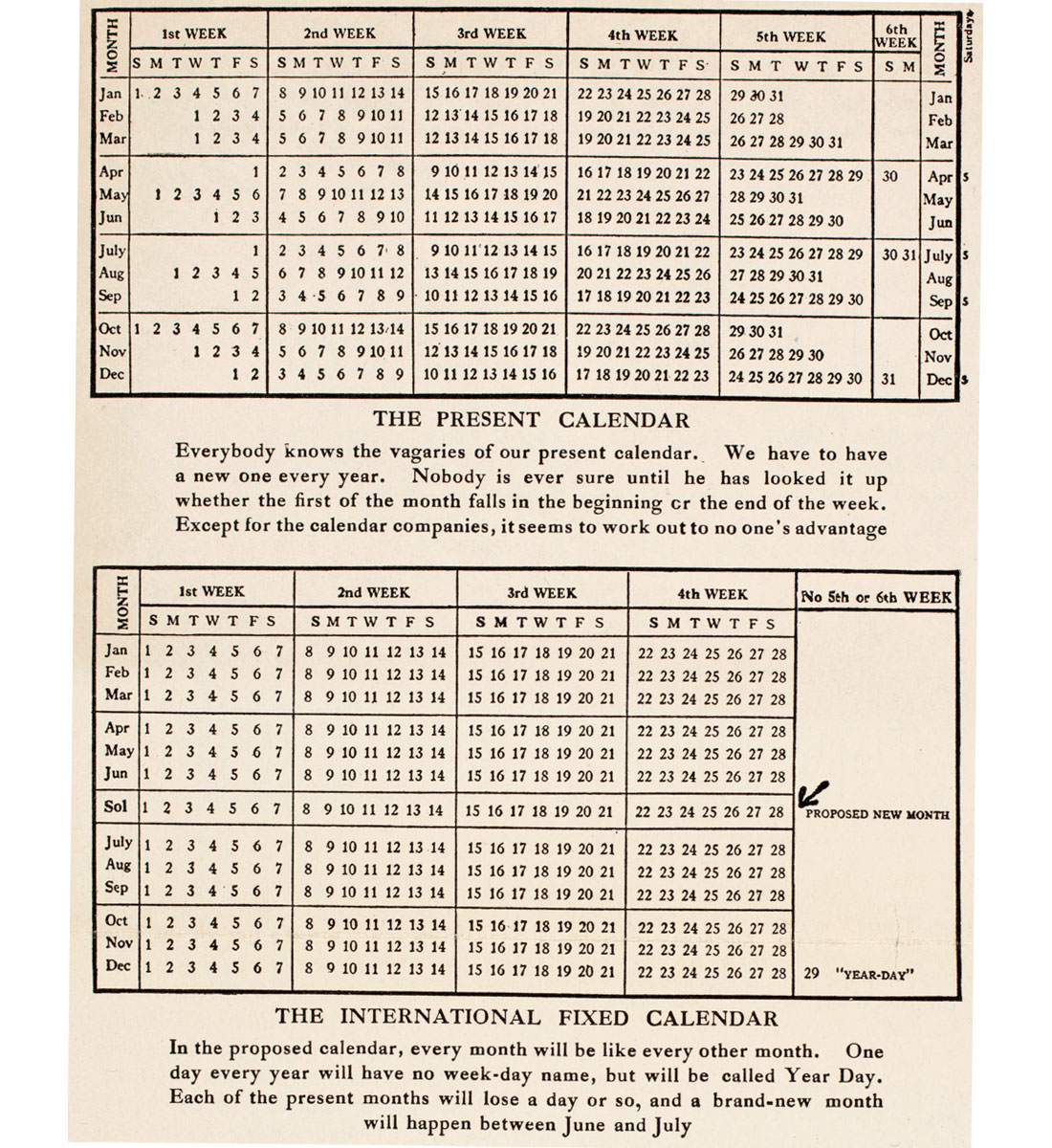
But how can the last month of the year be December if there are thirteen months, you may ask? All our current month names are retained, and the 13th month is inserted between June and July and given the name Sol, since it contains the northern hemisphere summer solstice.
The solar year is approximately 365 ¼ days, so this fixed calendar makes almost every 4 years a leap year, with an extra day added just as we do with the Gregorian calendar currently in use. It is placed in between Saturday, June 28 and Sunday, Sol 1. Again, you might ask, how can you always have the extra leap day between Saturday and Sunday, and what is it called? Well, the international fixed calendar really is fixed, so every year is identical, leap year or not, and every week and month begins on a Sunday and ends on a Saturday. The Year Day and Leap Day are just days added in and are special, not belonging to any month. I don’t know what the leap day is called, so I propose Leap Day – seems logical.
If we lived in a sane, sensible, rational world, we would likely all be using the International Fixed Calendar. And of course, people everywhere would drive on the same side of the road, electrical outlets would all be the same, dates would be expressed identically everywhere, the marine buoy system would not differ region to region… maybe we’d all be speaking Esperanto! But we don’t, and we never will, given the perversely and wonderfully contrarian nature of the human species, so beautifully reflected in our many calendars.











Share This Column